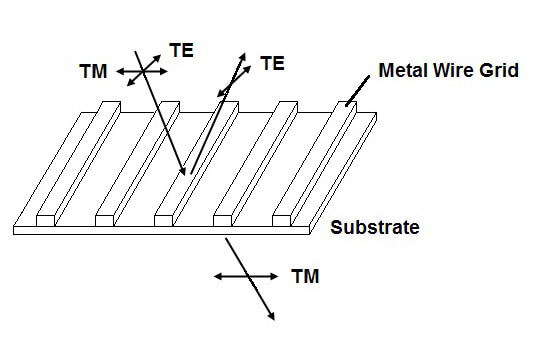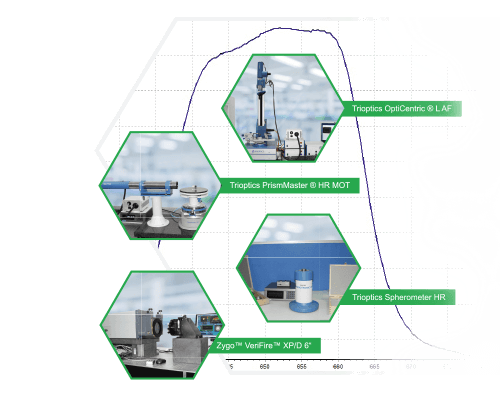
Polarizers are optical elements that can be used either to filter out a specific linear polarization component of a light beam or to separate the two linear polarization components into two separate beams.
The choice of technology depends on the specific requirements of the application. Under “Selection Guide” you will find the various factors that influence the selection.
Feel free to contact us for assistance. Our experienced staff is only too pleased to help you with the decision process.
| Type | Price | Power Handling | Angle Tolerance | Thickness | No. of Outputs | Separation Angle | Optical Quality (Wavefront Distortion) |
|---|---|---|---|---|---|---|---|
| Dichroic Polymer Sheet | Low | Low due to absorption | Very wide | Very thin (sheet) or thin (sandwich) | One (“filter”) | n.a. | Poor unless mounted between windows (sandwich) |
| Wire Grid | Mid to high | Mid | Very wide | Very thin | Two (“beamsplitter”) | Variable (2x AOI) | Good |
| Dielectric | Mid | Low (cemented) or high (optically contacted) | Very low to low | Thick=same as width of incidence plane | Two (“beamsplitter”) | 90° | Very good |
| Crystal (Refraction Angle Types)¹ | High | Low (cemented) or high (optically contacted) | Low | Thick to very thick | Two (“beamsplitter”) | 1° to 20° depending on type and material | Good to very good |
| Crsytal (TIR Types)² | High | Low (cemented) or high (optically contacted or air spaced) | Low to mid | Thick to very thick | One (“filter”) | n.a. | Good to very good |
¹Beam-Displacer, Wollaston, Rochon
²Glan Taylor, Glan Laser, Glan Thompson, Brewster, Foster
This type of polarizer employs an embedded aligned structure within a suitable matrix. For use in the visible range of wavelengths, the aligned structure is usually long polymer molecules – which serve as the matrix at the same time. In the infra-red, elongated micro-crystals serve as the aligned structure and are embedded in a suitable glass matrix.
The operational principle is as follows: the electric field of the light beam impinging on the molecules or micro-crystals excites an oscillation of the electrons within the aligned structure. This depletes the energy of the light wave, thus attenuating the power of the light beam. The attenuation is strongest for the electric field vector parallel to the aligned structure. Thus, this optic will transmit the polarization component perpendicular to the structures alignment direction. This type of polarizer is therefore a polarization filter, as only one component is transmitted and the other is absorbed.
Since this optic functions by absorption, it is only useful for low powers, typically in the mW range. Typical polarization extinction ratios (PER or contrast) will be in the range 1,000-10,000 in the visible and 1,000-100,000 in the IR. The acceptance angle can be very high meaning that the angle of incidence of the light beam onto the surface of the polarizer can be very high – almost up to 90°. This is particularly important for non-laser applications. Also, these polarizers can be quite large. Polymer sheet polarizers may be produced in areas of many m². In some cases, the flexibility of polymer sheets is not desired. In these cases, the sheet may be cemented between two windows forming a rigid optic with much lower wave front distortion.
This type of polarizer utilizes the fact that the ratio of transmission to reflection of a light beam incident at an angle on an interface is dependant on the orientation of the linear component of polarization. Consider the geometrical plane defined by the input and reflected rays when a light beam is incident at a non-normal angle onto a surface. One defines the linear polarization component whose polarization direction is parallel to this plane as the p-polarization. The component whose polarization is perpendicular to this plane is the s-polarization (from the German word “senkrecht” = perpendicular).
The p-polarization is preferably transmitted and the s-polarization is preferably reflected for all non-normal angles of incidence. At one special angle of incidence called the Brewster angle, the transmission of the p-polarization is perfect leading to a pure s-polarization in the reflected beam. This technique is used in dielectric plate polarizers requiring high power handling capability. A typical application is for Q-switching solid state lasers.
At other angles of incidence, the purity of polarization is not perfect. However, by cascading several interfaces in close proximity, the effect is multiplied and relatively high purity of polarization can be achieved at the useful angle of incidence of 45° and over a reasonably large range of angles about 45°, allowing use with typical laser beams. This “pile of plates” can be manufactured by coating the hypotenuse of a right-angle prism with several layers dielectric of alternating index of refraction. This dielectric stack is then enclosed inside a cube by cementing a second right-angle prism to this surface. This forms a cube beamsplitter in which the transmitted beam is p-polarized and is not deviated. The reflected beam is s-polarized and leaves the cube at 90° to the transmitted beam.
This type of polarizer separates the two linear polarization components and both can be used. However, the purity of polarization is not equal. Good polarizing beamsplitter cubes (PBSC) will have a polarization extinction ratio of 1000-2000 in transmission and 100-200 in reflection. If the cube is cemented, it will be of lower cost, but cannot handle high optical powers. For high optical powers the quality of the optics and coatings must be higher and the two prisms must be optically contacted (without cement). Such beamsplitters can handle several Joules/cm² of optical energy density in 10ns pulses (typical pulse durations for Q-switched lasers). Due to the technical difficulties involved in optical contacting, high power cubes are limited in size to about 25mm maximum. Cemented cubes can be made much larger, but the price increases rapidly due to the lower yield in the coating chamber.
A clear difficulty with this type of polarizer is the acceptance angle. This is the range of angles about the design angle of incidence over which the polarizer will operate to specification. Typically this value is about +/-2°. Artifex Engineering offers these optics with a particularly high specification of +/-5° giving us a definite technical advantage over other suppliers.
A further consideration is the thickness of the optic. Whereas dichroic polarizers may be thin sheets, the polarizing beamsplitter cube is by design just as thick as the input width in the direction of the plane of incidence/reflection. Note that the “cube” need not actually be cubic: the height (perpendicular to the plane of incidence/reflection) may take on any value.
This type of polarizer employs aligned micro-wires embedded in a glass or polymer matrix. The operational principle is as follows: the electric field of the light beam impinging on the micro-wires excites an oscillation of the conduction electrons within the aligned structure. If the polarization of the electric field is parallel to the orientation of the wires, the conduction electrons are free to oscillate and the structure acts essentially as a metal surface: the light beam is reflected. If the electric field is polarized perpendicular to the wire structure, the electrons are confined and the optical wave passes essentially unhindered.
Note that this optic can be used as a polarization filter at 0° angle of incidence (AOI) or as a polarization beamsplitter at any other AOI. When being used as a polarization filter, it is important to understand that the rejected light is actually reflected and not absorbed. This must be accounted for in the system design.
The acceptance angle of these polarizers is very high meaning that the angle of incidence of the light beam onto the surface of the polarizer can be very high – almost up to 90°. This is particularly important for non-laser applications. Also, these polarizers can be quite large. If the support matrix is a polymer, the flexibility of the polymer sheet may not be desired. In such cases, the sheet may be cemented between two windows forming a rigid optic with much lower wave front distortion.
This family of polarizers exploits the birefringence of certain crystals and the geometry of cutting the crystals to separate the two linear components of polarization. Birefringent crystals have a symmetry direction denoted as the optic axis. The indices of refraction for the linear polarization parallel to the optic axis (“extraordinary ray”) and perpendicular to it (“ordinary ray”) are different. Thus, at a crystal interface at non-zero angle of incidence to the optic axis or to the interface surface, the two polarizations will refract at differing angles, thus separating the two beams. This technique is used in the designs named “Wollaston prism”, “Rochon prism” and “beam displacing prism”. In all of these types of polarizer both polarization components are accessible at the outputs and are of high polarization purity. The purity of the polarization depends essentially only on the quality of the crystals used. Typical values of 105-106 can be achieved. Using selected crystals up to 107 is also feasible.
A disadvantage of this class of polarizer is that the separation angle between the two beams is usually quite small. Depending on the design and the material of the crystal, this may be as little as 1° (quartz Rochon prism) or as high as 20° (YVO4 Wollaston prism).
A second class of crystal polarizers employs a different physical principle. By judicious choice of orientation of the optic axes and cut angles of two birefringent prisms in contact, one can force a situation of total internal reflection (TIR) for the s-polarization while allowing the p-polarization to transmit through the interface. The transmitted beam is therefore purely p-polarized. Note however, that the reflected beam will contain the entire s-polarization component as well as the reflected portion of the p-polarization component and is therefore not a purely polarized beam.
There are several designs differing in orientation and cut of the crystals as well as whether the internal interface is cemented or air spaced. The most popular types are the “Glan Taylor”, “Glan Laser”, “Glan Thompson”, “Brewster” (or “High-Transmission”) and “Foster”. All of these types of polarizer attain similar levels of polarization extinction ratio as the Wollaston, etc. types – but only in the transmitted beam as discussed above. The advantage of this second class in cases where only one beam will be used is that the unwanted beam is eliminated or reflected out at a very large angle by design. Strictly speaking, one should think of these optics as polarization filters.
The great disadvantage of all crystal type polarizers is their bulky size and cost. However, in applications requiring high polarization purity, crystal polarizers cannot be beat. A typical example here is in ellipsometry.
We take quality control very seriously: we rely on accurate, widely recognized measurement systems for testing our optics. The following table indicates the accuracy of measurement for the most relevant parameters.
Surface figure: λ/20
Angle: 0,5 arcsec
Radius: 0,01%
Focal length: 0,03%-0,3%
Centration: +/-0,2µm or +/-2 arcsec
Wavelength: +/-0,3nm (190-1100nm)

We are known for:
Over 30 years experience in optics
ISO9001:2015 Certified
from the very first contact
at remarkable prices